2017 MITSUBISHI iMiEV seats
[x] Cancel search: seatsPage 81 of 296
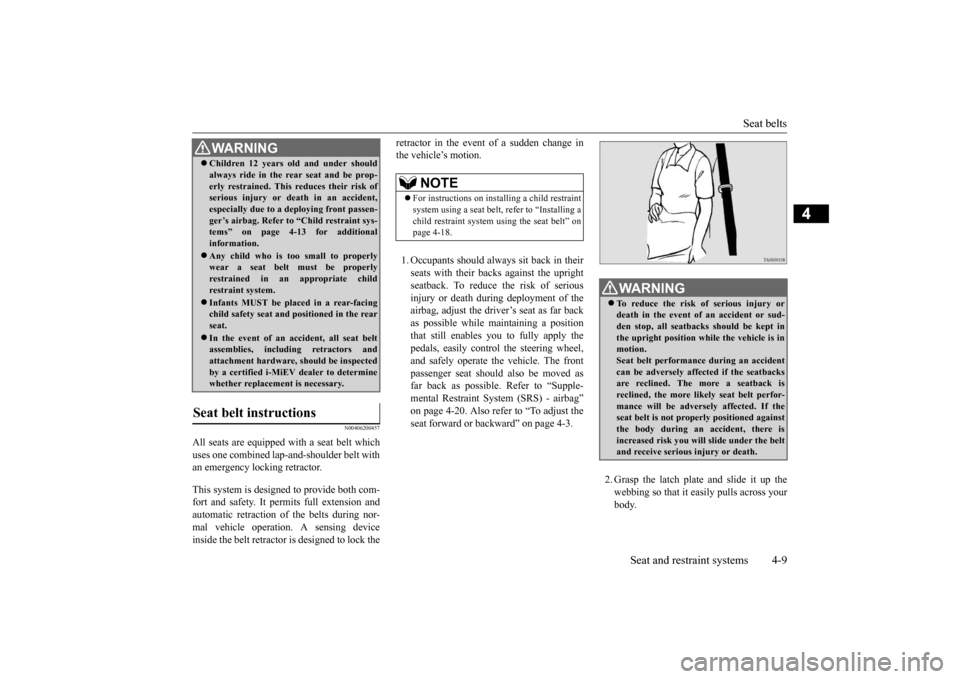
Seat belts
Seat and restraint systems 4-9
4
N00406200457
All seats are equipped with a seat belt which uses one combined lap-and-shoulder belt with an emergency locking retractor. This system is designed to provide both com- fort and safety. It perm
its full extension and
automatic retraction of the belts during nor- mal vehicle operation.
A sensing device
inside the belt retractor is designed to lock the
retractor in the event of a sudden change in the vehicle’s motion. 1. Occupants should always
sit back in their
seats with their backs against the upright seatback. To reduce
the risk of serious
injury or death during deployment of theairbag, adjust the driver’s seat as far back as possible while maintaining a position that still enables you to fully apply thepedals, easily control the steering wheel, and safely operate the vehicle. The front passenger seat should also be moved asfar back as possible. Refer to “Supple- mental Restraint System (SRS) - airbag” on page 4-20. Also refer to “To adjust theseat forward or backward” on page 4-3.
2. Grasp the latch plat
e and slide it up the
webbing so that it easily pulls across yourbody.
Children 12 years ol
d and under should
always ride in the re
ar seat and be prop-
erly restrained. This reduces their risk ofserious injury or de
ath in an accident,
especially due to a deploying front passen- ger’s airbag. Refer to
“Child restraint sys-
tems” on page 4-13 for additional information. Any child who is t
oo small to properly
wear a seat belt must be properly restrained in an appropriate childrestraint system. Infants MUST be placed in a rear-facing child safety seat and
positioned in the rear
seat. In the event of an ac
cident, all seat belt
assemblies, including retractors and attachment hardware, should be inspectedby a certified i-MiEV dealer to determine whether replacement is necessary.
Seat belt instructions
WA R N I N G
NOTE
For instructions on installing a child restraint system using a seat belt
, refer to “Installing a
child restraint system using the seat belt” on page 4-18.
WA R N I N G To reduce the risk of serious injury or death in the event of
an accident or sud-
den stop, all seatbacks should be kept in the upright position while the vehicle is inmotion. Seat belt performance during an accident can be adversely affect
ed if the seatbacks
are reclined. The more a seatback is reclined, the more likely seat belt perfor- mance will be advers
ely affected. If the
seat belt is not prop
erly positioned against
the body during an accident, there is increased risk you will slide under the beltand receive serious
injury or death.
BK0220401US.book 9 ページ 2015年6月3日 水曜日 午前7時42分
Page 83 of 296
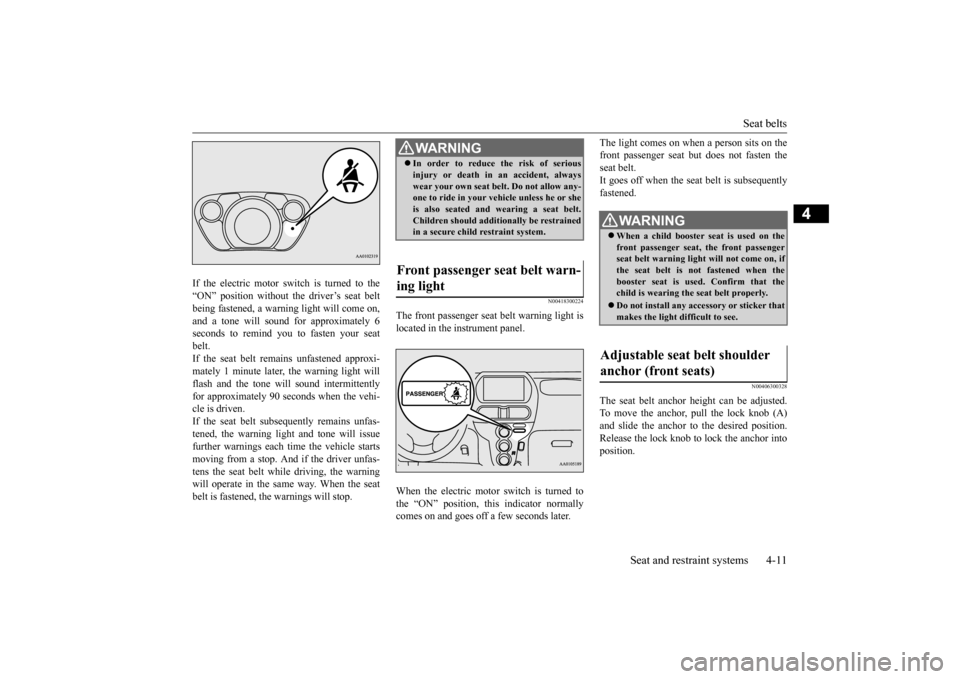
Seat belts
Seat and restraint systems 4-11
4
If the electric motor switch is turned to the “ON” position without the driver’s seat beltbeing fastened, a warning light will come on, and a tone will sound for approximately 6 seconds to remind you to fasten your seatbelt. If the seat belt remains unfastened approxi- mately 1 minute later, the warning light willflash and the tone wi
ll sound intermittently
for approximately 90 seconds when the vehi- cle is driven.If the seat belt subse
quently remains unfas-
tened, the warning light
and tone will issue
further warnings each time the vehicle startsmoving from a stop. And if the driver unfas- tens the seat belt while driving, the warning will operate in the same way. When the seatbelt is fastened, the warnings will stop.
N00418300224
The front passenger seat
belt warning light is
located in the instrument panel. When the electric motor switch is turned to the “ON” position, this indicator normally comes on and goes off a few seconds later.
The light comes on when a person sits on the front passenger seat bu
t does not fasten the
seat belt. It goes off when the seat belt is subsequently fastened.
N00406300328
The seat belt anchor height can be adjusted.To move the anchor, pull the lock knob (A) and slide the anchor to the desired position. Release the lock knob to lock the anchor intoposition.
WA R N I N G In order to reduce the risk of serious injury or death in
an accident, always
wear your own seat belt. Do not allow any-one to ride in your ve
hicle unless he or she
is also seated and
wearing a seat belt.
Children should additi
onally be restrained
in a secure child restraint system.
Front passenger seat belt warn- ing light
WA R N I N G When a child booster se
at is used on the
front passenger seat, the front passenger seat belt warning ligh
t will not come on, if
the seat belt is not fastened when thebooster seat is used
. Confirm that the
child is wearing the
seat belt properly.
Do not install any acce
ssory or sticker that
makes the light difficult to see.
Adjustable seat belt shoulder anchor (front seats)
BK0220401US.book 11 ページ 2015年6月3日 水曜日 午前7時42分
Page 84 of 296
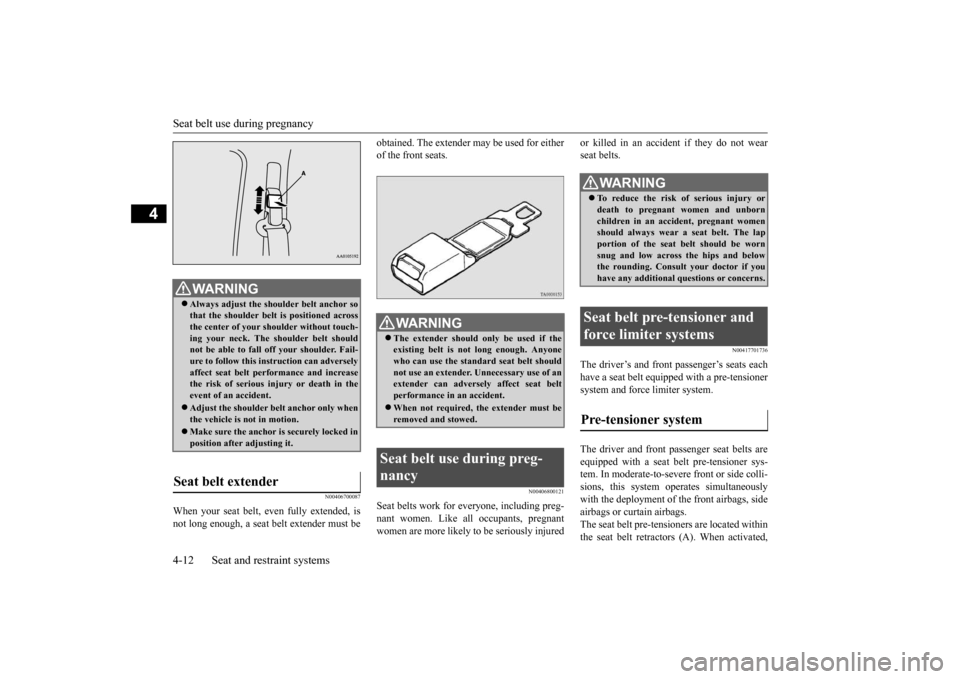
Seat belt use during pregnancy 4-12 Seat and restraint systems
4
N00406700087
When your seat belt, even fully extended, is not long enough, a seat belt extender must be
obtained. The extender may be used for either of the front seats.
N00406800121
Seat belts work for everyone, including preg-nant women. Like al
l occupants, pregnant
women are more likely to be seriously injured
or killed in an accide
nt if they do not wear
seat belts.
N00417701736
The driver’s and front passenger’s seats eachhave a seat belt equippe
d with a pre-tensioner
system and force limiter system. The driver and front pa
ssenger seat belts are
equipped with a seat belt pre-tensioner sys- tem. In moderate-to-seve
re front or side colli-
sions, this system ope
rates simultaneously
with the deployment of the front airbags, side airbags or curtain airbags. The seat belt pre-tensi
oners are located within
the seat belt retractors (A). When activated,
WA R N I N G Always adjust the shou
lder belt anchor so
that the shoulder belt
is positioned across
the center of your shoulder without touch- ing your neck. The sh
oulder belt should
not be able to fall off your shoulder. Fail-ure to follow this instruction can adversely affect seat belt performance and increase the risk of serious in
jury or death in the
event of an accident. Adjust the shoulder be
lt anchor only when
the vehicle is not in motion. Make sure the anchor is securely locked in position after adjusting it.
Seat belt extender
WA R N I N G The extender should only be used if the existing belt is not long enough. Anyonewho can use the standard seat belt should not use an extender.
Unnecessary use of an
extender can adversel
y affect seat belt
performance in an accident. When not required, the extender must be removed and stowed.
Seat belt use during preg- nancy
WA R N I N G To reduce the risk of serious injury or death to pregnant women and unborn children in an accident, pregnant women should always wear
a seat belt. The lap
portion of the seat belt should be worn snug and low across the hips and below the rounding. Consult your doctor if youhave any additional qu
estions or concerns.
Seat belt pre-tensioner and force limiter systems Pre-tensioner system
BK0220401US.book 12 ページ 2015年6月3日 水曜日 午前7時42分
Page 86 of 296
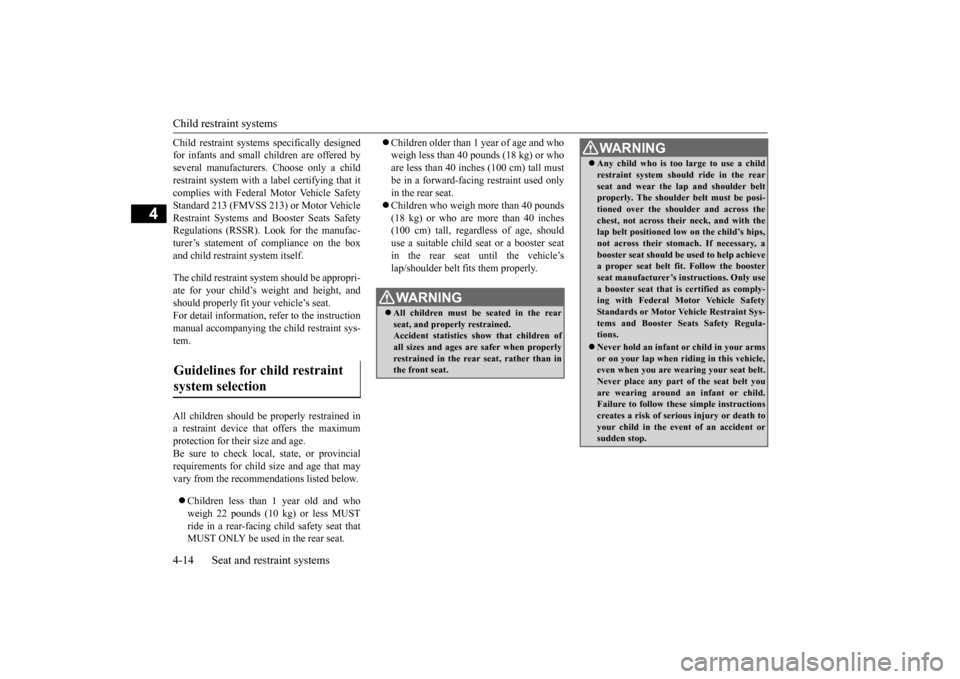
Child restraint systems 4-14 Seat and restraint systems
4
Child restraint systems specifically designed for infants and small children are offered byseveral manufacturers
. Choose only a child
restraint system with a label certifying that it complies with Federal Motor Vehicle SafetyStandard 213 (FMVSS 213) or Motor Vehicle Restraint Systems and Booster Seats Safety Regulations (RSSR). Look for the manufac-turer’s statement of compliance on the box and child restraint system itself. The child restraint system should be appropri- ate for your child’s we
ight and height, and
should properly fit you
r vehicle’s seat.
For detail information, refer to the instructionmanual accompanying the child restraint sys- tem. All children should be
properly restrained in
a restraint device that
offers the maximum
protection for their size and age. Be sure to check local, state, or provincial requirements for child size and age that mayvary from the recommendations listed below. Children less than 1 year old and who weigh 22 pounds (10 kg) or less MUST ride in a rear-facing child safety seat thatMUST ONLY be used in the rear seat.
Children older than 1 year of age and who weigh less than 40 pounds (18 kg) or whoare less than 40 inches (100 cm) tall must be in a forward-facing restraint used only in the rear seat. Children who weigh more than 40 pounds (18 kg) or who are more than 40 inches (100 cm) tall, regardless of age, shoulduse a suitable child seat or a booster seat in the rear seat until the vehicle’s lap/shoulder belt fits them properly.
Guidelines for child restraint system selection
WA R N I N G All children must be seated in the rear seat, and properly restrained. Accident statistics
show that children of
all sizes and ages are safer when properlyrestrained in the rear seat, rather than in the front seat.
Any child who is too large to use a child restraint system should ride in the rearseat and wear the la
p and shoulder belt
properly. The shoulder belt must be posi- tioned over the shou
lder and across the
chest, not across their neck, and with thelap belt positioned low on the child’s hips, not across their stomach. If necessary, a booster seat should be used to help achievea proper seat belt fi
t. Follow the booster
seat manufacturer’s instructions. Only use a booster seat that is certified as comply-ing with Federal Motor Vehicle Safety Standards or Motor Vehicle Restraint Sys- tems and Booster Seats Safety Regula-tions. Never hold an infant
or child in your arms
or on your lap when ri
ding in this vehicle,
even when you are we
aring your seat belt.
Never place any part of the seat belt youare wearing around an infant or child. Failure to follow these simple instructions creates a risk of serious injury or death toyour child in the event of an accident or sudden stop.WA R N I N G
BK0220401US.book 14 ページ 2015年6月3日 水曜日 午前7時42分
Page 92 of 296

Maintenance and inspection of seat belts 4-20 Seat and restraint systems
4
booster seat must be used
, to raise the child so
that the shoulder belt crosses their shoulderand the lap belt re
mains positioned low
across their hips. The
booster seat should fit
the vehicle seat and ha
ve a label certifying
compliance with Federal Motor Vehicle Safety Standards or Motor Vehicle Restraint Systems and Booster Se
ats Safety Regula-
tions.
N00407000351
The seat belt webbing
may be cleaned with
mild soap or detergent solution. Do not use an organic solvent. Allow the belts to dry in theshade. Do not allow them to retract until com- pletely dry. Do not attempt to bleach or re- dye the belts. The color may rub off and thewebbing strength may be affected. Regularly check your se
at belt buckles and
their release mechanisms
for positive engage-
ment and release of the
latch plate. Check the
retractors for automatic locking when in the Automatic Locking Retractor function. The entire seat belt assembly should be replaced if the webbing shows any obvious cuts, tears, increase in thickness in any sec- tion of the webbing from broken fibers, orsevere fading from sunlig
ht. All of these con-
ditions indicate a weakening of the belt, which may adversely affe
ct seat belt perfor-
mance in an accident.
N00407701834
This vehicle is equippe
d with a Supplemental
Restraint System (SRS), which includes air- bags for the driver and passengers. The SRS front airbags are designed to supple- ment the primary protection of the driver andfront passenger seat belt systems by provid- ing those occupants w
ith protection against
head and chest injuries
in certain moderate to
severe frontal
collisions.
The SRS front airbags, together with sensors at the front of the
vehicle and sensors
attached to the front seats, form an advanced airbag system. The SRS side airbags and the curtain airbags are also designed to s
upplement the seat belts.
The SRS side airbags provide the driver and front passenger with pr
otection against chest,
WA R N I N GAny child who is too small to properly wear a seat belt
must be properly
restrained in an appropriate child restraint system, to reduce their risk of serious injury or de
ath in an
accident.
A child should never be
left unattended in,
or unsupervised, around your vehicle.When you leave the
vehicle always take
the child out as well. Children can die from heat stroke if left or trapped inside the vehicle, especially on hot days. Keep your vehicle locked when not in use. Keep your vehicle keys away from chil-dren.
Maintenance and inspection of seat belts
WA R N I N G Do not attempt to repair or replace any part of the seat belt assemblies. This workshould be done by a certified i-MiEVdealer. Failure to h
ave a certified i-MiEV
dealer perform the work could reduce the effectiveness of the belts and could resultin a serious injury or
death in an accident.
Supplemental Restraint Sys- tem (SRS) - airbag
BK0220401US.book 20 ページ 2015年6月3日 水曜日 午前7時42分
Page 96 of 296

Supplemental Restraint System (SRS) - airbag 4-24 Seat and restraint systems
4
short period of time,
typically 30 seconds or
less. The EDR in this vehicle is designed to record such data as: How various systems in your vehicle were operating; Whether or not the driver safety belt was buckled/fastened; How far (if at all) the driver was depress- ing the accelerator and/or brake pedal; and, How fast the vehicle was traveling.
These data can help provide a better under- standing of the circumstances in which crashes and injuries occur. To read data recorded by an EDR, special equipment is required, and access to the vehi-
cle or the EDR is needed. In addition to the vehicle manufacturer, ot
her parties, such as
law enforcement, that have the special equip- ment, can read the information if they have access to the vehicle or the EDR.
N00417900210
The driver’s seat posit
ion sensor is attached
to the seat rail and provides the airbag control unit with information
on the seat’s fore-aft
position. The airbag control unit controlsdeployment of the driver’s front airbag in accordance with the information it receives from this sensor.If there is a problem involving the driver’s seat position sensor, th
e SRS warning light in
the instrument panel will come on. Refer to“SRS warning light” on page 4-26.
N00418000351
The passenger’s seat oc
cupant classification
sensor system is attached to the front passen- ger seat cushion and provides the airbag con- trol unit with inform
ation regarding the
occupant on the front passenger seat. The air- bag control unit controls deployment of the passenger’s front airbag in accordance withthe information it receives from this system. The passenger’s front airbag will not deploy in an impact when the system senses no occu-pant on the front passenger’s seat or a child in a child restraint system. In this case, the pas- senger’s airbag off indi
cator will come on.
Refer to “Passenger’s ai
rbag off indicator” on
page 4-25. If there is a problem involving the passen-ger’s seat occupant cl
assification sensor sys-
tem, the SRS warning light in the instrument panel will come on. Refer to “SRS warninglight” page 4-26.
NOTE
EDR data are recorded by your vehicle only if a non-trivial crash situation occurs; no dataare recorded by the EDR under normal driv- ing conditions and no personal data (e.g., name, gender, age, and crash location) arerecorded. However, ot
her parties, such as
law enforcement, could combine the EDR data with the type of
personally identifying
data routinely acquire
d during a crash inves-
tigation.
Driver’s seat position sensor
WA R N I N G If the SRS warning
light comes on, have
the vehicle inspected by a certified i-MiEV dealer as soon as possible. Please observe the following instructions to ensure that the driver’s seat position sensor can operate correctly.• Adjust the seat to the correct position,and sit well back
against the seatback.
Refer to “Front seats” on page 4-3.• Do not recline the seatback more thannecessary when driving.
• Do not place metall
ic objects or luggage
under the front seat.
If the vehicle is involved in a severe impact, have the SRS sensor inspected by a certified i-MiEV deal
er as soon as possi-
ble.
Passenger’s seat occupant clas- sification sensor system
WA R N I N G
BK0220401US.book 24 ページ 2015年6月3日 水曜日 午前7時42分
Page 97 of 296

Supplemental Restraint System (SRS) - airbag
Seat and restraint systems 4-25
4
N00418100310
The passenger’s airbag off indicator is located in the instrument panel.
The indicator normall
y comes on when the
electric motor switch is turned to the “ON”In the following situations, the indicator will stay on to show that
the passenger’s front air-
bag is not operational. The front passenger’s seat is not occupied. The system senses that a child is in the child restraint system
on the front passen-
ger’s seat.
When the passenger’s se
at occupant classifi-
cation sensor system se
nses there is a person
seated in the front passenger’s seat, the indi-cator goes out to show that the passenger’s front airbag is operational.
WA R N I N G If any of the following conditions occur, you should immediatel
y have your vehicle
inspected by a certified i-MiEV dealer assoon as possible:• The SRS warning light does not initiallycome on when the electric motor switch is turned to the “ON” or “START” posi- tion.• The SRS warning light does not go outafter several seconds.• The SRS warning li
ght comes on while
you are driving.
To ensure that the passenger’s seat occu- pant classification sensor system can sensecorrectly, observe the following instruc- tions. Failure to follow these instructions can adversely affect
the performance of
the passenger’s airbag system.• Adjust the seat to the correct position,and sit well back
against the seatback.
Refer to “Front seats” on page 4-3.• Do not recline the seatback more thannecessary.• Never have more th
an one person (adult
or child) sittin
g on the seat.
• Do not place anything between the seat and the floor console.• When attaching a child restraint system,secure it firmly.• Do not place luggage or other objects onthe seat.• Do not use a seat cover or a cushion.
• Do not modify or replace the seat and seat belt.• Do not place luggage or other objects under the seat.• Do not place and use
an electronic device
such as a computer on the seat.• Do not place heavy objects on the seat orstick pins, needles, or other objects into it.• Do not remove the seat cushion skin.• If any liquid is spilled on the seat, wipe it and dry the seat immediately.
If the vehicle is
involved in a severe
impact, have the SRS sensors inspected by a certified i-MiEV deal
er as soon as possi-
ble.
Passenger’s airbag off indicator
WA R N I N G
BK0220401US.book 25 ページ 2015年6月3日 水曜日 午前7時42分
Page 103 of 296
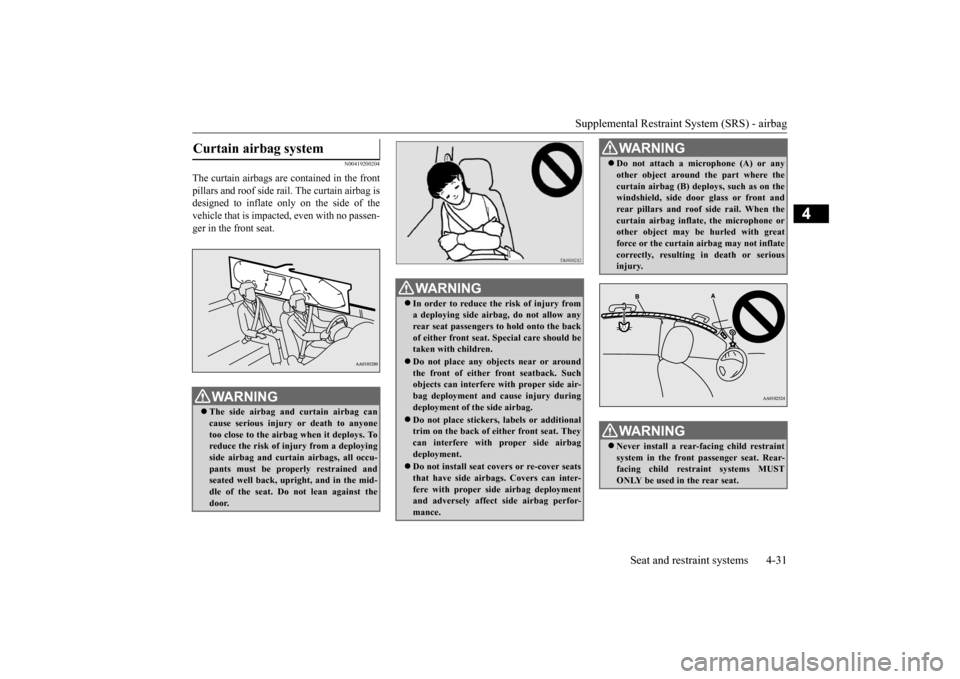
Supplemental Restraint System (SRS) - airbag
Seat and restraint systems 4-31
4
N00419200204
The curtain airbags are contained in the front pillars and roof side ra
il. The curtain airbag is
designed to inflate only on the side of thevehicle that is impacted
, even with no passen-
ger in the front seat.Curtain airbag system
WA R N I N G The side airbag and curtain airbag can cause serious injury
or death to anyone
too close to the airbag when it deploys. To reduce the risk of in
jury from a deploying
side airbag and curtai
n airbags, all occu-
pants must be properly restrained and seated well back, upright, and in the mid- dle of the seat. Do
not lean against the
door.
WA R N I N G In order to reduce the risk of injury from a deploying side airb
ag, do not allow any
rear seat passengers to hold onto the back of either front seat. Special care should betaken with children. Do not place any objects near or around the front of either front seatback. Such objects can interfere with proper side air- bag deployment and cause injury duringdeployment of the side airbag. Do not place stickers,
labels or additional
trim on the back of either front seat. They can interfere with proper side airbag deployment. Do not install seat c
overs or re-cover seats
that have side airbag
s. Covers can inter-
fere with proper si
de airbag deployment
and adversely affect
side airbag perfor-
mance.
Do not attach a microphone (A) or any other object around the part where thecurtain airbag (B) depl
oys, such as on the
windshield, side door glass or front and rear pillars and roof
side rail. When the
curtain airbag inflate,
the microphone or
other object may be
hurled with great
force or the curtain airbag may not inflate correctly, resulting in death or seriousinjury. WA R N I N G Never install a rear-facing child restraint system in the front passenger seat. Rear- facing child restraint systems MUST ONLY be used in the rear seat.WA R N I N G
BK0220401US.book 31 ページ 2015年6月3日 水曜日 午前7時42分